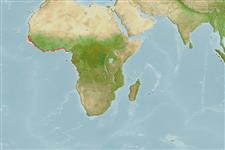>
Syngnathiformes (Pipefishes and seahorses) >
Syngnathidae (Pipefishes and seahorses) > Nerophinae
Etymology: Microphis: Greek, mikros = small + greek, ophis = serpent (Ref. 45335).
More on author: Kaup.
Environment: milieu / climate zone / depth range / distribution range
Écologie
marin; eau douce; saumâtre démersal; pH range: 7.5 - 8.2; dH range: 20 - 30. Tropical; 22°C - 26°C (Ref. 12468)
Africa: west coast of Africa, from Senegal to Angola (Ref. 81680).
Taille / Poids / Âge
Maturity: Lm ? range ? - ? cm
Max length : 20.0 cm SL mâle / non sexé; (Ref. 4509)
Description synthétique
Morphologie | Morphométrie
Épines dorsales (Total): 0; Rayons mous dorsaux (Total): 38-54; Épines anales 0; Rayons mous anaux: 2 - 3. Diagnosis: 41-44 bony rings (mode 43) (Ref. 81680), 19-21 (mode 20) trunk rings (before anus)(Ref. 57226, 81680) and 20-26 tail rings (behind anus)(Ref. 81680). 8.0-9.75 total subdorsal rings, 1.75-3.5, usually 2.5 or more, subdorsal trunk rings and 5.25-7.0, usually 5.75-6.5, subdorsal tail rings (Ref. 81680). Head length 4.8-5.6 (mean 5.2) times in SL (Ref. 57226, 81680). Snout 1.5-1.7 (mean 1.6) times in HL (Ref. 81680).
Coloration: general colour of preserved specimens dark brown, but pattern often highly variable within a single sample; lateral part of snout with dark brown blotches or stripes; body plain, blotched or with vague pale mid-lateral trunk stripe; dorsum and belly somewhat paler than flanks; ventral part of head light brown; opercle with numerous small dark brown spots and often a narrow horizontal dark, silvery stripe situated towards upper edge; caudal fin mainly brown with pale edging; other fins hyaline or with fin rays edged with brown; no consistent differences in preserved colouration of various subspecies (Ref. 81680).
Occurs in coastal rivers, streams and estuaries (Ref. 4127, 81680). Found in sea grasses and above sandy substrates in shallow water near shore a.o. (Ref. 81680). Ovoviviparous (Ref. 205). Breeds in fresh water (Ref. 81680). Male carries the eggs in a brood pouch found under the tail (Ref. 205). Eggs develop in the brood pouch for 1-3 weeks, until young of about 1.5 cm TL leave the pouch (Ref. 81680). Maximum reported total length for M. b. aculeatus 17.1 cm (Ref. 81680).
Life cycle and mating behavior
Maturité | Reproduction | Frai | Œufs | Fécondité | Larves
Eggs are attached to a kind of brood pouch, formed by two skin folds on the belly of the male (Ref. 13371).
Dawson, C.E., 1986. Syngnathidae. p. 281-287. In J. Daget, J.-P. Gosse and D.F.E. Thys van den Audenaerde (eds.) Check-list of the freshwater fishes of Africa (CLOFFA). ISNB, Brussels; MRAC, Tervuren; and ORSTOM, Paris. Vol. 2. (Ref. 4127)
Statut dans la liste rouge de l'IUCN (Ref. 130435)
Warning: mysqli::__construct(): (HY000/1040): Too many connections in /var/www/html/includes/func_getlabel.php on line 46
Can't connect to MySQL database (fbapp). Errorcode: Too many connections
